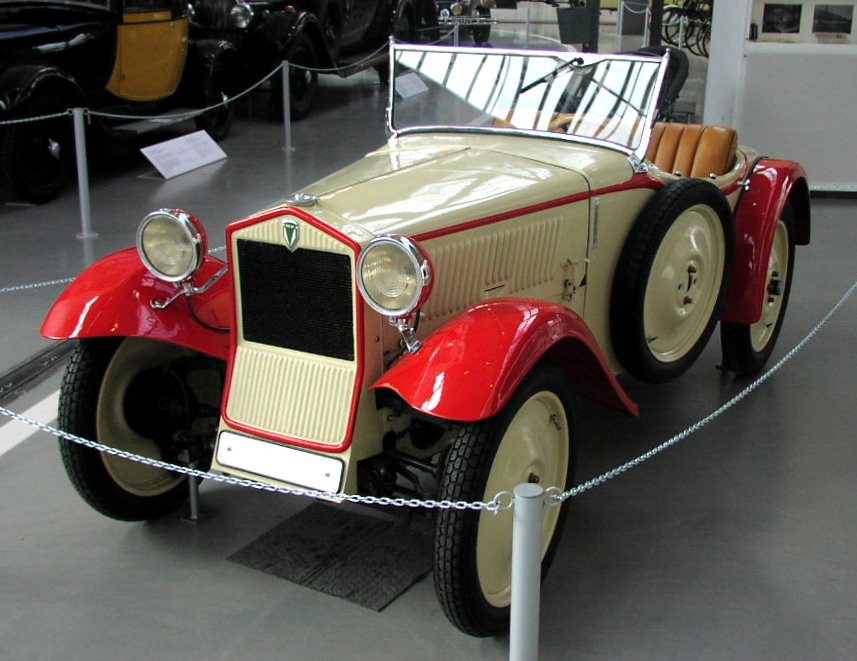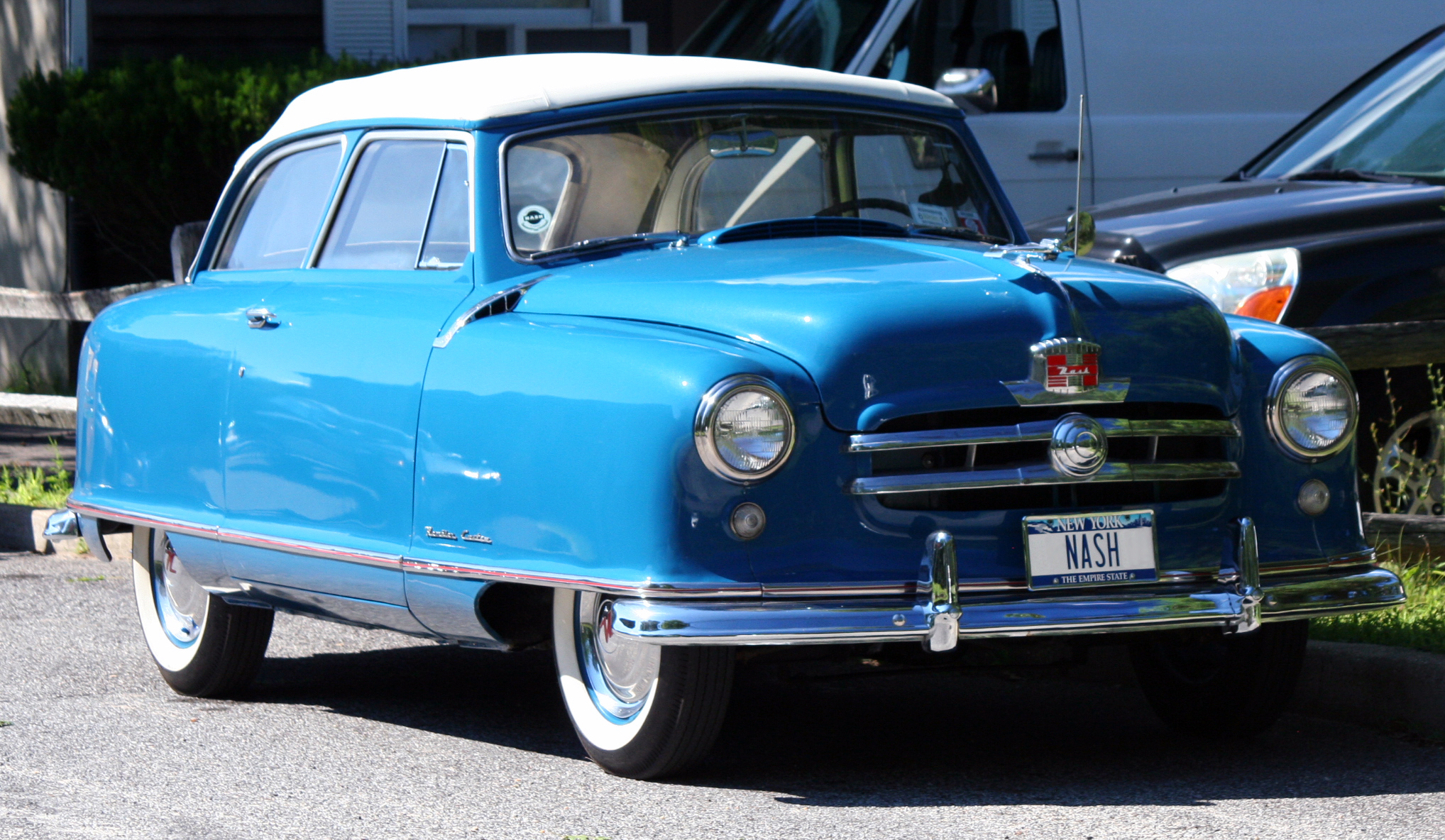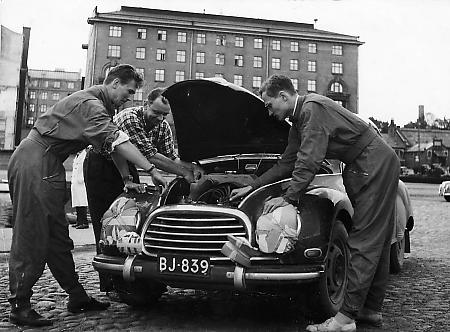|
DKW F5
The DKW F5 is a sub compact front wheel drive saloon launched by Auto Union's DKW division in 1935 as a replacement for the DKWs F4 (Meisterklasse) and F2 (Reichsklasse) models. The body The appearance of the F5 was little changed from those of the F2 and F4. However, the timber-frame construction of the central portion of the body was, in the F5, replaced with a steel frame. The outer skin of the body remained of fabric construction, with plywood support. There were two broadly similar F5 saloons, sold as the Reichsklasse and Meisterklasse. They shared the same track and wheelbase, but the Meisterklasse was 3.5 cm longer. There were also two-seater cabriolet versions of each, along with a lighter bodied ‘Front Luxus Sport’ sports cabriolet for which a higher top speed of was claimed. Engine and running gear The cars had the two-cylinder two-stroke engines of their predecessors. The Reichsklasse engine was of 584 cc with an output of . The Meisterklasse's 692 c ... [...More Info...] [...Related Items...] OR: [Wikipedia] [Google] [Baidu] |
Auto Union
Auto Union AG, was an amalgamation of four German automobile manufacturers, founded in 1932 and established in 1936 in Chemnitz, Saxony. It is the immediate predecessor of Audi as it is known today. As well as acting as an umbrella firm for its four constituent brands (Audi, Horch, DKW, Wanderer), Auto Union is widely known for its racing team (''Auto Union Rennabteilung'', based at Horch works in Zwickau/Saxony). The Silver Arrows of the two German teams (Mercedes-Benz and Auto Union) dominated not only GP car racing from 1934 onwards but set records that would take decades to beat, such as the fastest speed ever attained on a public road (at 432.7 km/h (268.9 mph), a record lasting until 2017. After being reduced to near ruin in the aftermath of World War II, Auto Union was re-founded in Ingolstadt, Bavaria, in 1949, ultimately evolving into the modern day Audi company following its takeover by Volkswagen in 1964 and later merger with NSU Motorenwerke in 1969. ... [...More Info...] [...Related Items...] OR: [Wikipedia] [Google] [Baidu] |
Front Wheel Drive
Front-wheel drive (FWD) is a form of engine and transmission layout used in motor vehicles, where the engine drives the front wheels only. Most modern front-wheel drive vehicles feature a transverse engine, rather than the conventional longitudinal engine arrangement generally found in rear-wheel drive and four-wheel drive vehicles. Location of engine and transmission By far the most common layout for a front-wheel drive car is with the engine and transmission at the front of the car, mounted transversely. Other layouts of front-wheel drive that have been occasionally produced are a front-engine mounted longitudinally, a mid-engine layout and a rear-engine layout. History Prior to 1900 Experiments with front-wheel drive cars date to the early days of the automobile. The world's first self-propelled vehicle, Nicolas-Joseph Cugnot's 1769/1770 "fardier à vapeur", was a front-wheel driven three-wheeled steam-tractor. It then took at least a century, for the firs ... [...More Info...] [...Related Items...] OR: [Wikipedia] [Google] [Baidu] |
Front-wheel-drive Vehicles
Front-wheel drive (FWD) is a form of engine and transmission layout used in motor vehicles, where the engine drives the front wheels only. Most modern front-wheel drive vehicles feature a transverse engine, rather than the conventional longitudinal engine arrangement generally found in rear-wheel drive and four-wheel drive vehicles. Location of engine and transmission By far the most common layout for a front-wheel drive car is with the engine and transmission at the front of the car, mounted transversely. Other layouts of front-wheel drive that have been occasionally produced are a front-engine mounted longitudinally, a mid-engine layout and a rear-engine layout. History Prior to 1900 Experiments with front-wheel drive cars date to the early days of the automobile. The world's first self-propelled vehicle, Nicolas-Joseph Cugnot's 1769/1770 "fardier à vapeur", was a front-wheel driven three-wheeled steam-tractor. It then took at least a century, for the first e ... [...More Info...] [...Related Items...] OR: [Wikipedia] [Google] [Baidu] |
Compact Cars
Compact as used in politics may refer broadly to a pact or treaty; in more specific cases it may refer to: * Interstate compact * Blood compact, an ancient ritual of the Philippines * Compact government, a type of colonial rule utilized in British North America * Compact of Free Association whereby the sovereign states of the Federated States of Micronesia, the Republic of the Marshall Islands and the Republic of Palau have entered into as associated states with the United States. * Mayflower Compact, the first governing document of Plymouth Colony * United Nations Global Compact * Global Compact for Migration, a UN non-binding intergovernmental agreement Mathematics * Compact element, those elements of a partially ordered set that cannot be subsumed by a supremum of any directed set that does not already contain them * Compact operator, a linear operator that takes bounded subsets to relatively compact subsets, in functional analysis * Compact space, a topological space such th ... [...More Info...] [...Related Items...] OR: [Wikipedia] [Google] [Baidu] |
DKW Vehicles
DKW (''Dampf-Kraft-Wagen'', en, "steam-powered car", also ''Deutsche Kinder-Wagen'' en, "German children's car". ''Das-Kleine-Wunder'', en, "the little wonder" or ''Des-Knaben-Wunsch'', en, "the boy's wish"- from when the company built toy two-stroke engines) was a German car- and motorcycle-marque. DKW was one of the four companies that formed Auto Union in 1932 and thus became an ancestor of the modern-day Audi company. In 1916, Danish engineer Jørgen Skafte Rasmussen founded a factory in Zschopau, Saxony, Germany, to produce steam fittings. That year he attempted to produce a steam-driven car, called the DKW.Odin, L.C. ''World in Motion 1939 – The whole of the year's automobile production''. Belvedere Publishing, 2015. ASIN: B00ZLN91ZG. Although unsuccessful, he made a two-stroke toy engine in 1919, called ''Des Knaben Wunsch'' – "the boy's wish". He put a slightly modified version of this engine into a motorcycle and called it ''Das Kleine Wunder'' – "the litt ... [...More Info...] [...Related Items...] OR: [Wikipedia] [Google] [Baidu] |
Two-stroke
A two-stroke (or two-stroke cycle) engine is a type of internal combustion engine that completes a Thermodynamic power cycle, power cycle with two strokes (up and down movements) of the piston during one power cycle, this power cycle being completed in one revolution of the crankshaft. A four-stroke engine requires four strokes of the piston to complete a power cycle during two crankshaft revolutions. In a two-stroke engine, the end of the combustion stroke and the beginning of the compression stroke happen simultaneously, with the intake and exhaust (or Scavenging (automotive), scavenging) functions occurring at the same time. Two-stroke engines often have a high power-to-weight ratio, power being available in a narrow range of rotational speeds called the power band. Two-stroke engines have fewer moving parts than four-stroke engines. History The first commercial two-stroke engine involving cylinder compression is attributed to Scotland, Scottish engineer Dugald Clerk, who pa ... [...More Info...] [...Related Items...] OR: [Wikipedia] [Google] [Baidu] |
Roadster (automobile)
A roadster (also spider, spyder) is an open two-seat car with emphasis on sporting appearance or character. Initially an American term for a two-seat car with no weather protection, usage has spread internationally and has evolved to include two-seat convertibles. The roadster was also a style of racing car driven in United States Auto Club (USAC) Championship Racing, including the Indianapolis 500, in the 1950s and 1960s. This type of racing car was superseded by rear-mid-engine cars. Etymology The term "roadster" originates in the United States, where it was used in the 19th century to describe a horse suitable for travelling. By the end of the century, the definition had expanded to include bicycles and tricycles. In 1916, the United States Society of Automobile Engineers defined a roadster as: "an open car seating two or three. It may have additional seats on running boards or in rear deck." Since it has a single row of seats, the main seat for the driver and passenger w ... [...More Info...] [...Related Items...] OR: [Wikipedia] [Google] [Baidu] |
Sedan (car)
A sedan or saloon (British English) is a passenger car in a three-box configuration with separate compartments for an engine, passengers, and cargo. The first recorded use of the word "sedan" in reference to an automobile body occurred in 1912. The name derives from the 17th-century litter known as a sedan chair, a one-person enclosed box with windows and carried by porters. Variations of the sedan style include the close-coupled sedan, club sedan, convertible sedan, fastback sedan, hardtop sedan, notchback sedan, and sedanet/sedanette. Definition A sedan () is a car with a closed body (i.e. a fixed metal roof) with the engine, passengers, and cargo in separate compartments. This broad definition does not differentiate sedans from various other car body styles, but in practice, the typical characteristics of sedans are: * a B-pillar (between the front and rear windows) that supports the roof * two rows of seats * a three-box design with the engine at the front and the car ... [...More Info...] [...Related Items...] OR: [Wikipedia] [Google] [Baidu] |
Compact Car
Compact car is a vehicle size class — predominantly used in North America — that sits between subcompact cars and mid-size cars. "Small family car" is a British term and a part of the C-segment in the European car classification. However, prior to the downsizing of the United States car industry in the 1970s and 1980s, larger vehicles with wheelbases up to were considered "compact cars" in the United States. In Japan, small size passenger vehicle is a registration category that sits between kei cars and regular cars, based on overall size and engine displacement limits. United States Current definition The United States Environmental Protection Agency (EPA) ''Fuel Economy Regulations for 1977 and Later Model Year'' (dated July 1996) includes definitions for classes of automobiles. Based on the combined passenger and cargo volume, compact cars are defined as having an ''interior volume index'' of . 1930s to 1950s The beginnings of U.S. production of compact cars we ... [...More Info...] [...Related Items...] OR: [Wikipedia] [Google] [Baidu] |
Zwickau
Zwickau (; is, with around 87,500 inhabitants (2020), the fourth-largest city of Saxony after Leipzig, Dresden and Chemnitz and it is the seat of the Zwickau District. The West Saxon city is situated in the valley of the Zwickau Mulde (German: ''Zwickauer Mulde''; progression: ), and lies in a string of cities sitting in the densely populated foreland of the Elster and Ore Mountains stretching from Plauen in the southwest via Zwickau, Chemnitz and Freiberg to Dresden in the northeast. From 1834 until 1952, Zwickau was the seat of the government of the south-western region of Saxony. The name of the city is of Sorbian origin and may refer to Svarog, the Slavic god of fire and of the sun. Zwickau is the seat of the West Saxon University of Zwickau (German: ''Westsächsische Hochschule Zwickau'') with campuses in Zwickau, Markneukirchen, Reichenbach im Vogtland and Schneeberg (Erzgebirge). The city is the birthplace of composer Robert Schumann. As cradle of Audi's forerunner ... [...More Info...] [...Related Items...] OR: [Wikipedia] [Google] [Baidu] |
DKW F5 Sport-Roadster, Bj
DKW (''Dampf-Kraft-Wagen'', en, "steam-powered car", also ''Deutsche Kinder-Wagen'' en, "German children's car". ''Das-Kleine-Wunder'', en, "the little wonder" or ''Des-Knaben-Wunsch'', en, "the boy's wish"- from when the company built toy two-stroke engines) was a German car- and motorcycle- marque. DKW was one of the four companies that formed Auto Union in 1932 and thus became an ancestor of the modern-day Audi company. In 1916, Danish engineer Jørgen Skafte Rasmussen founded a factory in Zschopau, Saxony, Germany, to produce steam fittings. That year he attempted to produce a steam-driven car, called the DKW.Odin, L.C. ''World in Motion 1939 – The whole of the year's automobile production''. Belvedere Publishing, 2015. ASIN: B00ZLN91ZG. Although unsuccessful, he made a two-stroke toy engine in 1919, called ''Des Knaben Wunsch'' – "the boy's wish". He put a slightly modified version of this engine into a motorcycle and called it ''Das Kleine Wunder'' – "the lit ... [...More Info...] [...Related Items...] OR: [Wikipedia] [Google] [Baidu] |
FF Layout
In automotive design, a front-engine, front-wheel-drive (FWD) layout, or FF layout, places both the internal combustion engine and driven roadwheels at the front of the vehicle. Usage implications Historically, this designation was used regardless of whether the entire engine was behind the front axle line. In recent times, the manufacturers of some cars have added to the designation with the term '' front-mid'' which describes a car in which the engine is in front of the passenger compartment but behind the front axle. The engine positions of most pre– World-War-II cars are ''front-mid'' or on the front axle. This layout is the most traditional form and remains a popular, practical design. The engine, which takes up a great deal of space, is packaged in a location passengers and luggage typically would not use. The main deficit is weight distribution—the heaviest component is at one end of the vehicle. Car handling is not ideal, but usually predictable. In contrast wi ... [...More Info...] [...Related Items...] OR: [Wikipedia] [Google] [Baidu] |
.jpg)









